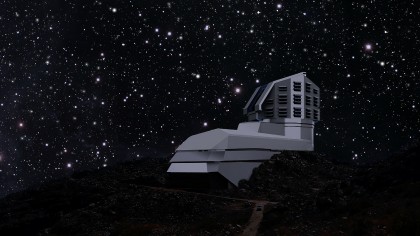Can tech save us from giant asteroids like 2015 TB145?
We're safe on 31 October, but is Earth a sitting duck?

Main image: Reconstruction of the path of the asteroid that exploded over Chelyabinsk, Russia, on 15 February 2013. Image credit: Olga Kruglova & Sandia Labs CC BY-NC-ND 2.0
Given the scale of space, what's going to occur at just over a moon's length from Earth on Halloween has to be classed as a celestial near-miss. Headed our way – but predicted to miss Earth by about 500,000km – is 2015 TB145, a giant rock that's 28 times bigger than the Chelyabinsk meteor which hit Russia in February 2013. Its closeness has caused NASA to class TB145 as 'potentially hazardous'.
No warning

Forget movies like Deep Impact and Armageddon – when as asteroid even this big comes towards Earth, astronomers get little advance notice. NASA's Near-Earth Object Observation Program (NEOO) identified TB145 only a few weeks ago via the Panoramic Survey Telescope and Rapid Response System (Pan-STARRS-1) in Hawaii.
"It turns out that near-Earth asteroids fly-by the Earth with some regularity, many times with less advance notice than we have for 2015 TB145," says Dr. Nick Moskovitz, a planetary astronomer who researches, and searches for, near-Earth objects at Lowell Observatory in Arizona, USA. "For example, an object designated 2015 TC25 was discovered on October 11 about two days before it flew by the Earth at a distance of about 100,000 km, more than three times closer than TB145."
2015 TC25, however, was much smaller than TB145, and would likely have burned up in the atmosphere if it had been on a collision course with Earth.
How serious would it be if TB145 smashed into Earth?

"The energy from such an impact would be the equivalent of about 100 of the biggest nuclear weapons ever detonated," says Moskovitz. "This would definitely have significant regional effects on the scale of many hundreds or even thousands of miles."
The most famous asteroid impact so far occurred in Tunguska, a remote area of Siberia, in 1908. The impact is estimated to have been about 1,000 times more powerful than an atomic bomb, and the shockwave devastated over 800 square miles, felling 80 million trees.
Sign up for breaking news, reviews, opinion, top tech deals, and more.
Events like Tunguska and the Chelyabinsk meteor and rare purely because the chances of an asteroid striking land – let alone an urban area – are remote (Tunguska was so remote that its effects weren't photographed until the 1930s). However, a sizeable asteroid hitting the ocean could still be deadly. "An impact of this asteroid landing in the ocean, which would be most likely, could result in a significant tsunami," says Moskovitz.

Just how big is TB145?
This is a big asteroid, probably somewhere between 200-600 meters across according to Moskovitz, although he points out that we'll only know the size after observations conducted as it passes Earth at around 125,500km/h. That astronomers can measure the size of objects as big as TB145 only as they pass by may be alarming, but the chances of Earth being hit are actually very small.
"We don't get hit by objects in that size range very often, only about once every 10,000 years," says Moskovitz. "Space is big, there is a lot of stuff out there, and we would have to be extraordinarily unlucky to be hit by one of these objects."
Are we doing enough to find near-Earth objects?

NASA's Near Earth Object Observations Program (NEOO) says TB145 will be the biggest asteroid to sweep near Earth until August 2027, although it's only basing that on what it's picked up so far – an asteroid called 1999 AN10 – and there may well be other objects lurking out there.
There's a lack of funding for NEO detection systems, and most use small 1-2 metre telescopes to scan large portions of the sky over and over again. A next-gen system is badly needed, and that's exactly what the Large Synoptic Survey Telescope (LSST) promises. An 8.4-meter telescope with a 3,200-megapixel camera, from about 2023 the LSST will scan the sky for faint NEOs from its high-altitude location in Cerro Pachón, Chile.

Jamie is a freelance tech, travel and space journalist based in the UK. He’s been writing regularly for Techradar since it was launched in 2008 and also writes regularly for Forbes, The Telegraph, the South China Morning Post, Sky & Telescope and the Sky At Night magazine as well as other Future titles T3, Digital Camera World, All About Space and Space.com. He also edits two of his own websites, TravGear.com and WhenIsTheNextEclipse.com that reflect his obsession with travel gear and solar eclipse travel. He is the author of A Stargazing Program For Beginners (Springer, 2015),